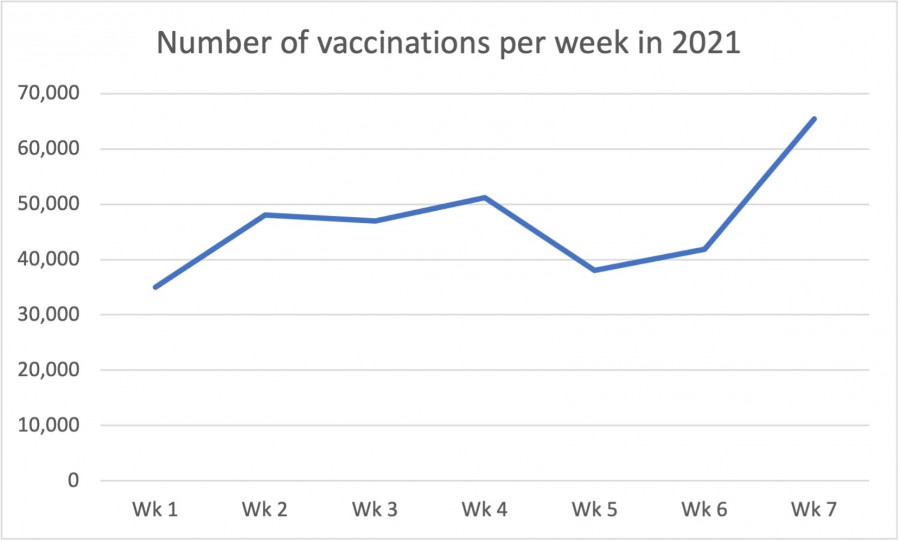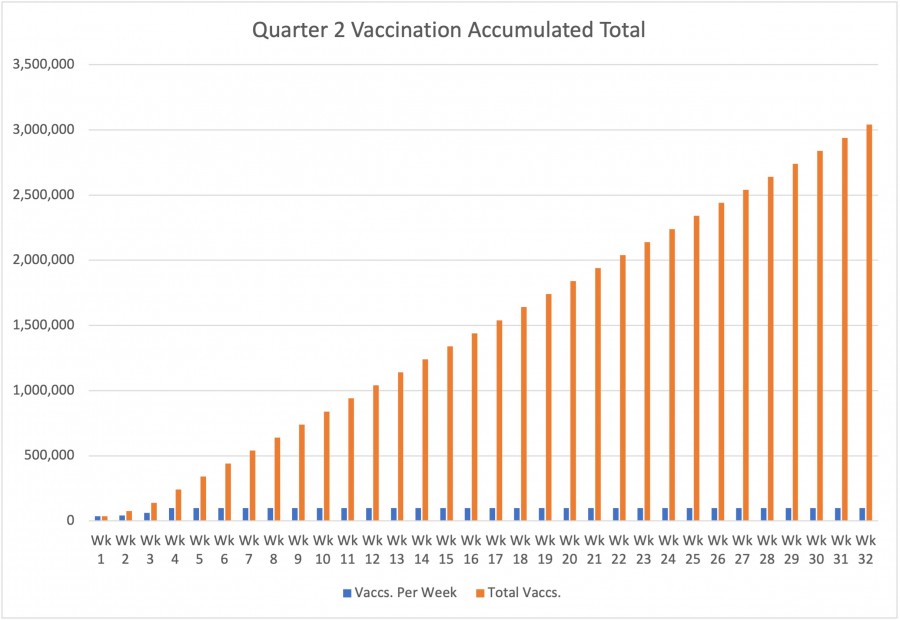February 21 2021.
While the rate of vaccinations has increased, it still hasn’t reached the government’s original target of 100,000 per week. It seems to be mainly due to availability of vaccines – GPs around the country haven’t been able to bring in their most elderly patients yet because they don’t have the vaccine stock. At this point, the group of 85 and older have not fully vaccinated. The slow rollout means that people at most risk – including the three-quarters of a million citizens over retirement age – remain at risk and many will have to ‘self-coccoon’ for safety. The slow roll-out also pushes out the date at which some sort of normality can return (effectively when the most vulnerable categories have been fully innoculated). Even if the 100,000 rate is achieved this week, and maintained for the rest of the summer, it will still be mid-May before the vulnerable categories are protected (assuming that the government stick with the 2-jab approach)
February 8 2021.
The good news is that the vaccination program is slightly ahead of the HSE’s prediction, as of February 3rd. The bad news is that the rate of vaccinations per week has still not exceeded 50,000 per week since the beginning of the year. It had been hoped to be close to 100,000 per week by now. It’s unlikely to increase rapidly for the rest of the month (due in part to unavailability of vaccines). As a result, it’s difficult to see restrictions being lifted in any meaningful way at the beginning of March, as planned.
Up to last Friday, 230,766 doses of vaccine were administered. This accounts for 151,212 first doses and 79,554 second doses. #COVID19 #COVIDVaccine
— Stephen Donnelly (@DonnellyStephen) February 8, 2021
The Minister’s tweet demonstrates the size of the challenge – while 150K people protected seems like a large number, it doesn’t even cover the number of people who are at least eighty years old (half were given to healthcare workers). Until they are vaccinated, anyone over seventy is at risk, and will have to either coccoon or practice self-imposed distancing (as will their relatives). Even at the rate of 50K vaccines per month, the over-seventies won’t all have their first jab until Easter, and it will be mid-May before they are fully vaccinated.
January 18 2021 (original post). It’s heartening that the Covid-19 vaccination program has begun, but the stated targets by the government will be challenging to reach. The plan¹ is to have 700,000 people vaccinated by the end of March (Quarter 1) and 1,500,000 by the end of June (Quarter 2). Assuming that each of those people will receive their second jab within 3 weeks of their first one, the March target is really 1,400,000 jabs by the 3rd week of April. Similarly, the Quarter 2 (June deadline) is effectively a target of 3 million jabs by the 3rd week of July.
The government hope¹ that vaccinations will take place at a rate of 100,000 per week by February. Assuming that the 100,000 rate per week is an operational ceiling, the HSE would need to hit that rate next week to meet their Quarter 1 deadline (see Slide 1 below). Even then, they will overshoot their Q1 deadline – Week 16 is the last week of April.
Slide 1 – Quarter 1 vaccination projection.
The overshoot in Quarter 1 will have a knock-on effect for the Quarter 2 target – at 100K jabs per week, it will take until the middle of August (WK 32) to give 3 million jabs to 1.5 million people (which is rougly equivalent to vaccinating every person over fifty in the country) .
Slide 2 – Quarter 2 vaccination projection.
That estimate assumes that the health service can sustain a steady rate of vaccination even during the summer (and for simplification, assumes that every possible dose is administered to a person). There are almost 5 million people living in the country, of which more than 3.5 million are adults³. Three and a half million people need seven million jabs and it would take until the middle of 2022 to achieve that (assuming the 100K per week rate). Even in a best case scenario, it looks like we will be living with [at least some] Covid restrictions for most of the year.



